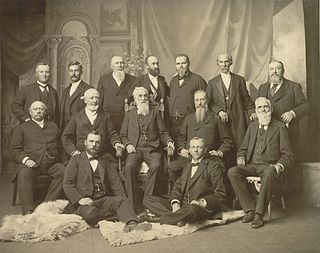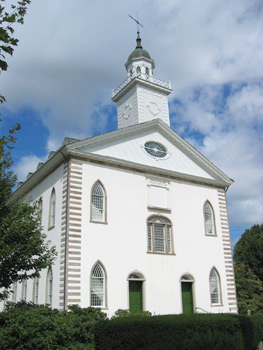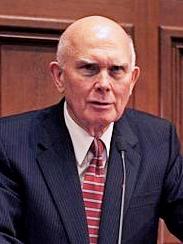The First Presidency of Community of Christ , formerly the Reorganized Church of Jesus Christ of Latter Day Saints, is the church's highest-ranking priesthood quorum. It is composed of the Prophet-President and two counselors, and they preside over the whole church under the principles of "theocratic democracy" observed in the governance of the church. This includes responsibility for the World Conference, field ministries, priesthood quorums and orders, and headquarters functions. The president of the Church holds the priesthood office of Prophet and is also a High Priest.
In 1860 with the reorganization of the First Presidency, Joseph Smith III became the second prophet-president of this church and also president of a new First Presidency. William Marks became Smith's First Counselor.
In Community of Christ, each new church president has generally been "designated" as the successor by the preceding church president. The counselors in the First Presidency are then chosen by the church president and are often, but not required, to be former or current members of the Council of Twelve Apostles. In addition, the death or resignation of the Prophet-President does not dissolve the First Presidency, which continues on as the church's executive council in the persons of the remaining two presidents until a Prophet-President is called. The two members who were counselors to the prophet-president cease to be counselors during this time. Upon ordination of the Prophet-President, the former First Presidency is dissolved, and upon ordination of the two counselors, it is reorganized. Members of the First Presidency are not members of the Quorum of Twelve nor do they hold the priesthood office of apostle, regardless of previous calling.
Prior to 1996, all prophet-presidents were descendants of the movement's founder, Joseph Smith Jr. This pattern was broken by Wallace B. Smith, who designated W. Grant McMurray church president. McMurray, in turn, resigned the church presidency in 2004 without designating a successor. A joint council of church leaders led by the Council of Twelve Apostles announced in March 2005 that Stephen M. Veazey was selected as Prophet-President designate. Veazey had been serving as president of the Council of Twelve. Delegates elected to a special World Conference of the church approved Veazey and he was ordained as the 8th president of the High Priesthood, Prophet, and President of the Church on June 3, 2005.
At the 2007 World Conference, Becky L. Savage was ordained as the first woman to serve in the First Presidency. [1]
Current members of the First Presidency are: [2]
- President Stephen M. Veazey, President of the Church
- President Stassi D. Cramm (Counselor to the president)
- President K. Scott Murphy (Counselor to the president)

Community of Christ, known from 1872 to 2001 as the Reorganized Church of Jesus Christ of Latter Day Saints (RLDS), is an American-based international church, and is the second-largest denomination in the Latter Day Saint movement. The church reports approximately 250,000 members in 1,100 congregations in 59 countries. The church traces its origins to Joseph Smith's establishment of the Church of Christ on April 6, 1830. His eldest son Joseph Smith III formally accepted leadership of the church on April 6, 1860 in the aftermath of the 1844 death of Joseph Smith.
President of the Quorum of the Twelve Apostles is a priesthood calling in the Church of Jesus Christ of Latter-day Saints. Normally, the president of the Quorum of the Twelve is the most senior apostle in the church, aside from the president of the church. When the president of the church dies, it is the president of the Quorum of the Twelve who becomes the new church president. The calling of President of the Twelve has been held by 27 men. 16 Quorum Presidents have subsequently become President of the Church. Since January 2018, Dallin H. Oaks has been the President of the Quorum of the Twelve. Since Oaks is also first counselor in the First Presidency, M. Russell Ballard served as acting president until his death on November 12, 2023. Jeffrey R. Holland became the new acting president on November 15, 2023.
Among many churches in the Latter Day Saint movement, the First Presidency is the highest presiding or governing body. Present-day denominations of the movement led by a First Presidency include the Church of Jesus Christ of Latter-day Saints, the Community of Christ, Remnant Church of Jesus Christ of Latter Day Saints, and the Righteous Branch of the Church of Jesus Christ of Latter-Day Saints.
In the Latter Day Saint movement, an apostle is a "special witness of the name of Jesus Christ who is sent to teach the principles of salvation to others." In many Latter Day Saint churches, an apostle is a priesthood office of high authority within the church hierarchy. In many churches, apostles may be members of the Quorum of the Twelve and First Presidency of the church. In most Latter Day Saint churches, modern-day apostles are considered to have the same status and authority as the Biblical apostles.

In the Church of Jesus Christ of Latter-day Saints, the Quorum of the Twelve Apostles is one of the governing bodies in the church hierarchy. Members of the Quorum of the Twelve Apostles are apostles, with the calling to be prophets, seers, and revelators, evangelical ambassadors, and special witnesses of Jesus Christ.
In the Latter Day Saint movement, the President of the Church is generally considered to be the highest office of the church. It was the office held by Joseph Smith, founder of the movement, and the office assumed by many of Smith's claimed successors, such as Brigham Young, Joseph Smith III, Sidney Rigdon, and James Strang. Several other titles have been associated with this office, including First Elder of the church, Presiding High Priest, President of the High Priesthood, Trustee-in-Trust for the church, Prophet, Seer, Revelator, and Translator. Joseph Smith was known by all of these titles in his lifetime.
Seventy is a priesthood office in the Melchizedek priesthood of several denominations within the Latter Day Saint movement, including the Church of Jesus Christ of Latter-day Saints. Traditionally, a Latter Day Saint holding this priesthood office is a "traveling minister" and an "especial witness" of Jesus Christ, charged with the mission of preaching the gospel to the entire world under the direction of the Twelve Apostles. Latter Day Saints teach that the office of seventy was anciently conferred upon the seventy disciples mentioned in the Gospel of Luke 10:1-2. Multiple individuals holding the office of seventy are referred to collectively as "seventies".

William Marks was an early leader in the Latter Day Saint movement and was a member of the First Presidency in the Reorganized Church of Jesus Christ of Latter Day Saints. Marks is mentioned in the Doctrine and Covenants in sections 117 and 124 of the Church of Jesus Christ of Latter-day Saints edition and in section 115 of the Community of Christ edition.
In the Community of Christ, the Council of Twelve Apostles is one of the governing bodies in the church hierarchy. They are disciples who hold the priesthood office of apostle, and are responsible for the evangelistic witness of the church. Apostles are also high priests in the Melchizedek priesthood of the church.
The succession crisis in the Latter Day Saint movement occurred after the murder of Joseph Smith, the movement's founder, on June 27, 1844.
W. Grant McMurray was Prophet-President of Community of Christ from 1996 until 2004. He was the first non-descendant of Joseph Smith to head the church, and under his administration, the Reorganized Church of Jesus Christ of Latter Day Saints changed its name to Community of Christ.
A Rigdonite is a member of the Latter Day Saint movement who accepts Sidney Rigdon as the successor in the church presidency to the movement's founder, Joseph Smith Jr. The early history of the Rigdonite movement is shared with the history of the Latter Day Saint movement, but as of the 1844 succession crisis becomes distinct. Sidney Rigdon and other church leaders, including Brigham Young and James J. Strang, presented themselves as leaders of the movement and established rival church organizations. Rigdon's group was initially headquartered in Pittsburgh, Pennsylvania. It was known at one point as the Church of Jesus Christ of the Children of Zion, and its adherents are referred to as Rigdonites, or sometimes "Pennsylvania Latter Day Saints" or "Pennsylvania Mormons." The only surviving organization that traces its succession back to Rigdon's organizations is The Church of Jesus Christ, founded by a group of Rigdon's followers led by William Bickerton.
In Community of Christ, formerly the Reorganized Church of Jesus Christ of Latter Day Saints, priesthood is God's power and authority to minister in the church and to conduct God's business on Earth. Although the church believes that all Christians are called by their gifts and talents to the ministry, priesthood is seen as a particular expression of universal ministry to which all are called. In Community of Christ, both women and men can be ordained to the priesthood. All offices are deemed equal in importance, but the duties and responsibilities of each differ.

The history of Community of Christ, formerly known as the Reorganized Church of Jesus Christ of Latter Day Saints, covers a period of approximately 200 years. The church's early history traces to the "grove experience" of Joseph Smith, who prayed in the woods near his home in Palmyra, New York, in the early-19th century. Several accounts of this experience have surfaced over the years. Most of the accounts share a common narrative indicating that when he went to the woods to pray, he experienced a period of encountering evil or despair, but then experienced an epiphany or vision in which he came to know and understand God's goodness. Later, as an adult, Smith founded the Church of Christ on April 6, 1830.

The First Presidency, also called the Quorum of the Presidency of the Church or simply the Presidency, is the presiding governing body of the Church of Jesus Christ of Latter-day Saints. It is composed of the President of the Church and his counselors. The First Presidency currently consists of Russell M. Nelson and his two counselors: Dallin H. Oaks and Henry B. Eyring.
In the Latter Day Saint movement, the Quorum of the Twelve is one of the governing bodies of the church hierarchy organized by the movement's founder Joseph Smith and patterned after the Apostles of Jesus. Members are called Apostles, with a special calling to be evangelistic ambassadors to the world.
Assistant President of the Church was a position in the leadership hierarchy in the early days of the Latter Day Saint church founded by Joseph Smith. The Assistant President was the second-highest authority in the church and was a member of the church's governing First Presidency. As President of the Church, Smith appointed two men to serve in the position of Assistant President. After Smith's death, most Latter Day Saint denominations discontinued the position of Assistant President of the Church.

The President of the Church is the highest office of the Church of Jesus Christ of Latter-day Saints. It was the office held by Joseph Smith, the church's founder. The church's president is its leader and the head of the First Presidency, its highest governing body. Latter-day Saints consider the president of the church to be a "prophet, seer, and revelator" and refer to him as "the Prophet", a title that was originally given to Smith. When the name of the president is used by adherents, it is usually prefaced by the title "President". Russell M. Nelson has been the president since January 14, 2018.
Apostolic succession in the Church of Jesus Christ of Latter-day Saints is the process of transition to a new church president when the preceding one has died.























